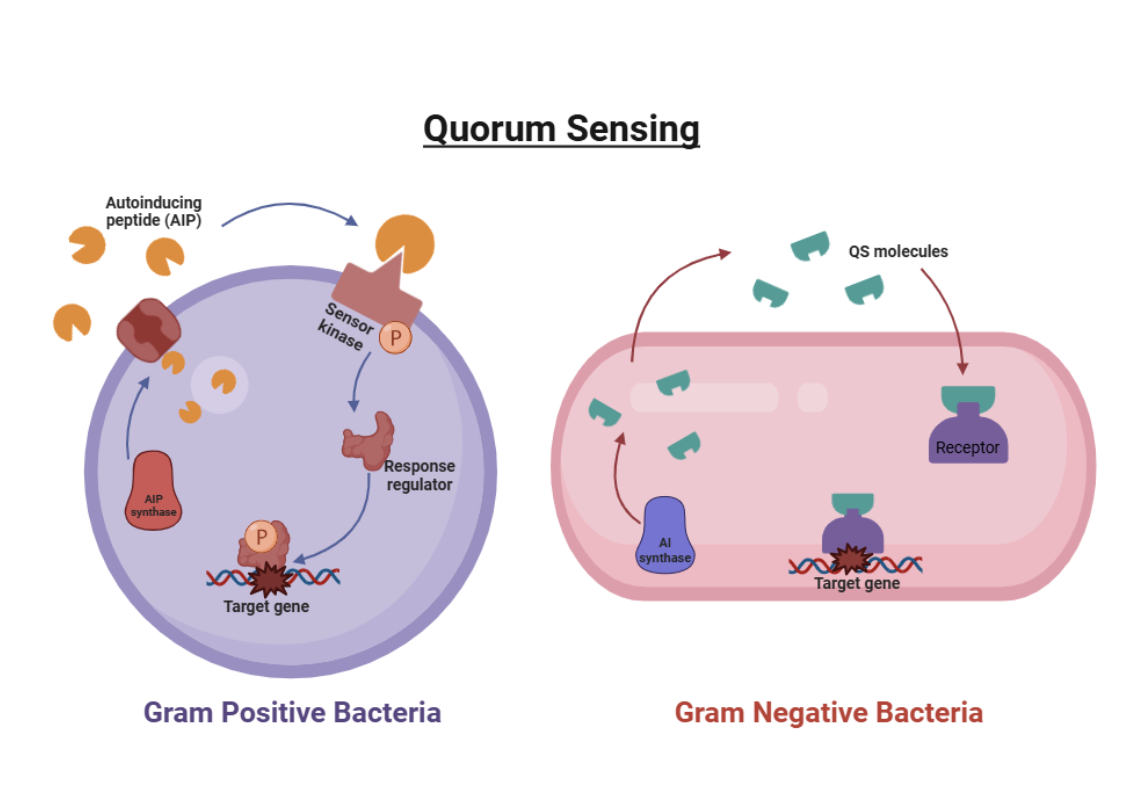The Parallel Between Human and Plant Metabolic Systems
At the heart of both human health and plant growth lies the intricate relationship between microbiomes and their environments.
For humans, the gut microbiome is crucial to our overall health and longevity [1][2]. Similarly, plants rely on the microbiome within their rhizosphere—the area surrounding their roots—to maintain growth, resilience, and immunity. In both cases, the bacteria's communication with each other, aka quorum sensing (QS) plays a pivotal role in regulating these microbial communities and influencing health outcomes.
Bacteria communicate through the release of QS signaling molecules, some are known as autoinducers, which detect and respond to changes in microbial population. In humans, these microbial communities reside in the gut, where they interact also with the human host.
Recent studies have shown that quorum sensing can participate in the regulation of certain physiological processes, including metabolism, immune function, and pathogen defense. Bacterial species in the gut microbiota use various signalings to respond to environmental stimuli and regulate some gene expressions, which can impact health outcomes like inflammation, gut permeability, and even neurodegenerative diseases. [3]
Furthermore, the gut’s microbial ecosystem has been linked to the body’s ability to detoxify, metabolize nutrients, and manage stress, thereby influencing aging and longevity.
In parallel, plants also use signaling to coordinate some microbial activities in their rhizosphere—the network of microorganisms surrounding their roots.[4] These microbial communities in the rhizosphere play a vital role in nutrient absorption, disease resistance, and overall plant health.
Just like in the human gut, quorum sensing among rhizosphere bacteria helps plants adapt to environmental stress, regulate growth, and boost immune responses.
Soil microbiomes in the rhizosphere communicate to optimize nutrient cycling, which enhances plant resilience, particularly in the face of extreme environmental conditions such as drought, soil degradation, and pest attacks.
Astrobiome® and the Power of Quorum Sensing in Both Humans and Plants.
Astrobiome®'s Beyond Organic Biostimulant (BOB™) works by enhancing quorum sensing within the plant's rhizosphere. This is achieved by introducing selected bacterial strains that improve microbial communication, leading to better nutrient uptake, stress resilience, and overall plant health.
By mimicking natural stressors that wild plants face—such as environmental challenges and microbial interactions—Astrobiome® can induce a more robust metabolic response in plants, enriching their nutrient profile and boosting their defense mechanisms.
The result shows healthier, more resilient plants that thrive in controlled environments, much like how the gut microbiome optimizes human health by managing stress, nutrients, and immunity.
In the human body, when bacteria in the gut microbiome interact through quorum sensing, they produce bioactive compounds that influence the body's metabolic pathways, including the production of short-chain fatty acids (SCFAs) that are critical for gut health, immune modulation, and reducing inflammation.
Similarly, plants exposed to BOB™ may produce enhanced metabolites that improve their growth, immunity, and nutrient content. By promoting these beneficial metabolic changes, both plants and humans can experience improved health outcomes, including better stress management, increased resilience to disease, and enhanced longevity.
Note that BOB™ for plants and Astrobiome® Postbiotics for humans are entirely different products.
They use different strains and processes to target their respective applications—BOB™ to improve plant resilience and nutritional value, and Postbiotics™ to enhance human health.
While they share a similar concept of leveraging natural stressors to promote health, and both convey health effects from microbes to humans, e.g., via metabolites; BOB™ uses plants as an intermediary. The benefits of BOB™ extend beyond plant growth, creating a unique synergy between plant resilience and human health. As plants grown with BOB™ produce higher concentrations of beneficial metabolites, these compounds, when consumed, offer a direct benefit to human health.
For instance, flavonoids, polyphenols, and other secondary metabolites are known for their antioxidant, anti-inflammatory, and immune-boosting properties, all of which play crucial roles in promoting longevity and reducing the risk of age-related diseases.
For plants, the improvement in QS, including inter-communication and communication between the plants and microbes, within the rhizosphere can allow them to thrive in less-than-ideal conditions, even in soil degraded by overuse of synthetic fertilizers. The enhanced resilience that comes from this optimized microbial activity can not only improve the health of the plants, but also can contribute to more nutritious, sustainable crops. These plants can provide higher levels of essential nutrients, supporting human health and longevity, while also reducing the need for synthetic pesticides and fertilizers.
Hence parallel metabolic systems of humans and plants are intertwined, with BOB™ enhancing both the plant’s defense mechanisms and the health benefits of the food we consume.
Just as microbial communication in the human gut microbiome can help regulate metabolism, immunity, and aging processes, the microbial communication in the rhizosphere, supported by BOB™, optimizes nutrient uptake and stress tolerance in plants.
This interconnected approach to health—linking plant resilience and human longevity—may provide valuable insights for enhancing agricultural practices and supporting human well-being.
References:
Quorum Sensing in Humans and Gut Health: Research on quorum sensing’s role in human health can be found in studies published in Nature Microbiology and Cell Host & Microbe. These studies explore how microbial communication affects immune function, metabolism, and disease resistance. “The gut microbiota serves the host in a variety of physiological ways, including maintaining gut epithelium integrity, facilitating digestion, producing vital metabolites and vitamins, suppressing pathogen expansion, and regulating host immunity”[1,2,5]
Quorum Sensing and Plant Health: Studies on plant-microbe interactions in the rhizosphere and their impact on plant growth and stress resilience are discussed in journals such as Plant and Soil and Microorganisms. These studies highlight the role of microbial communication in nutrient cycling, disease resistance, and plant immunity.[6, 7, 8]




